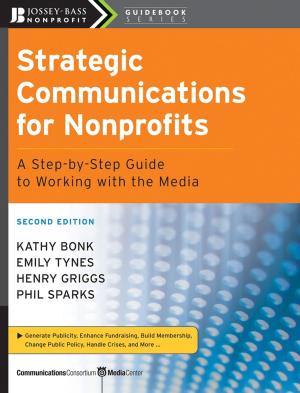Why Organizations Thrive: Lessons from the Front Lines for Nonprofit Executive Directors
Business & Finance, Industries & Professions, Nonprofit Organizations & Charities| Author: | Jonathan Poisner | ISBN: | 9781301766314 |
| Publisher: | Jonathan Poisner | Publication: | April 26, 2013 |
| Imprint: | Smashwords Edition | Language: | English |
| Author: | Jonathan Poisner |
| ISBN: | 9781301766314 |
| Publisher: | Jonathan Poisner |
| Publication: | April 26, 2013 |
| Imprint: | Smashwords Edition |
| Language: | English |
On January 2, 1997, I showed up for my first day of work as the Executive Director of the Oregon League of Conservation Voters (Oregon LCV).
The Board shouldn’t have hired me.
I was only 30. I had zero fundraising experience, virtually no personnel supervision experience, and had only been involved previously with one other nonprofit organization.
I was given lots of training to make up for my lack of knowledge. They generally covered the specific skills I needed -- fundraising, financial management, and board development, to name a few.
What I rarely encountered was training that identified the patterns of behavior that separate Executive Directors who make their organizations thrive from those that merely do okay.
In my own experience over a dozen years as an Executive Director, and in collaborating with, volunteering with, and consulting for dozens of nonprofits, I’ve come away convinced it’s not primarily about the skill set.
It’s about how those skills are applied, with what emphasis, and with what mind-set.
This is the book I wish I’d been able to read in my first year as an Executive Director. Or my third. Or my fifth for that matter.
The book's fifteen lessons provide a mix of theory and practical tips that should be of value to any nonprofit leader looking to step up the level of their work.
On January 2, 1997, I showed up for my first day of work as the Executive Director of the Oregon League of Conservation Voters (Oregon LCV).
The Board shouldn’t have hired me.
I was only 30. I had zero fundraising experience, virtually no personnel supervision experience, and had only been involved previously with one other nonprofit organization.
I was given lots of training to make up for my lack of knowledge. They generally covered the specific skills I needed -- fundraising, financial management, and board development, to name a few.
What I rarely encountered was training that identified the patterns of behavior that separate Executive Directors who make their organizations thrive from those that merely do okay.
In my own experience over a dozen years as an Executive Director, and in collaborating with, volunteering with, and consulting for dozens of nonprofits, I’ve come away convinced it’s not primarily about the skill set.
It’s about how those skills are applied, with what emphasis, and with what mind-set.
This is the book I wish I’d been able to read in my first year as an Executive Director. Or my third. Or my fifth for that matter.
The book's fifteen lessons provide a mix of theory and practical tips that should be of value to any nonprofit leader looking to step up the level of their work.















